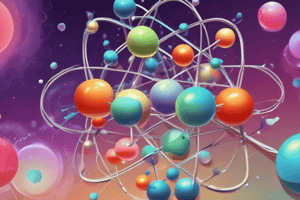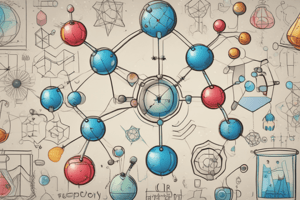Podcast
Questions and Answers
Why is Democritus's view of matter considered only an idea, while Dalton's view is considered a theory?
Why is Democritus's view of matter considered only an idea, while Dalton's view is considered a theory?
Democritus's idea of matter does not relate atoms to a measurable property, while Dalton's theory can be tested through quantitative experimentation.
Give an example of a chemical or physical process that illustrates the law of conservation of mass.
Give an example of a chemical or physical process that illustrates the law of conservation of mass.
A glass of ice cubes will have the same mass when the ice has completely melted into liquid water, even though its volume will change.
State two principles from Dalton's atomic theory that have been revised as new information has become available.
State two principles from Dalton's atomic theory that have been revised as new information has become available.
Atoms are divisible into smaller particles called subatomic particles. A given element can have atoms with different masses, called isotopes.
What parts of Dalton's atomic theory are illustrated by the reaction 2H2 O2 → 2H2O?
What parts of Dalton's atomic theory are illustrated by the reaction 2H2 O2 → 2H2O?
If 3 g of element C combine with 8 g of element D to form compound CD, how many grams of D are needed to form compound CD2?
If 3 g of element C combine with 8 g of element D to form compound CD, how many grams of D are needed to form compound CD2?
Which law do these data illustrate?
Which law do these data illustrate?
State the law regarding chemical compounds.
State the law regarding chemical compounds.
Calculate the ratio of the masses of nitrogen that combine with oxygen for compound NO.
Calculate the ratio of the masses of nitrogen that combine with oxygen for compound NO.
Calculate the ratio of the masses of nitrogen that combine with oxygen for compound NO2.
Calculate the ratio of the masses of nitrogen that combine with oxygen for compound NO2.
Calculate the ratio of the masses of nitrogen that combine with oxygen for compound NO4.
Calculate the ratio of the masses of nitrogen that combine with oxygen for compound NO4.
Which law do these data illustrate in relation to nitrogen and oxygen compounds?
Which law do these data illustrate in relation to nitrogen and oxygen compounds?
In cathode-ray tubes, the cathode ray is emitted from the negative electrode, which is called the?
In cathode-ray tubes, the cathode ray is emitted from the negative electrode, which is called the?
The smallest unit of an element that can exist either alone or in molecules is called what?
The smallest unit of an element that can exist either alone or in molecules is called what?
A positively charged particle found in the nucleus is called a(n)?
A positively charged particle found in the nucleus is called a(n)?
A nuclear particle that has no electrical charge is called a(n)?
A nuclear particle that has no electrical charge is called a(n)?
The subatomic particles that are least massive and most massive, respectively, are the?
The subatomic particles that are least massive and most massive, respectively, are the?
What property of the cathode ray is shown by various phenomena including its deflection by a magnetic field?
What property of the cathode ray is shown by various phenomena including its deflection by a magnetic field?
How would the electrons produced in a cathode-ray tube filled with neon gas compare with those from chlorine gas?
How would the electrons produced in a cathode-ray tube filled with neon gas compare with those from chlorine gas?
Is an atom positively charged, negatively charged, or neutral?
Is an atom positively charged, negatively charged, or neutral?
Explain how an atom can exist in a neutral state.
Explain how an atom can exist in a neutral state.
Before Rutherford's experiment, which illustration of the atom was believed to be correct?
Before Rutherford's experiment, which illustration of the atom was believed to be correct?
After Rutherford's experiment, which illustration of the atom was believed to be correct?
After Rutherford's experiment, which illustration of the atom was believed to be correct?
What is the proton known for?
What is the proton known for?
What is the neutron known for?
What is the neutron known for?
Where is the electron located?
Where is the electron located?
Flashcards are hidden until you start studying
Study Notes
Democritus vs. Dalton
- Democritus considered matter as indivisible atoms, but his ideas lacked measurable properties.
- Dalton's atomic theory involves quantifiable experimentation, leading to its acceptance as a scientific theory.
Law of Conservation of Mass
- Melting ice cubes exemplify this law, as the mass remains unchanged despite a change in state from solid to liquid (ice to water).
Revisions in Dalton's Theory
- Atoms can be subdivided into subatomic particles like protons, neutrons, and electrons.
- Elements may have isotopes, which are atoms with the same number of protons but different masses.
Water Formation Reaction
- The reaction 2H₂ + O₂ → 2H₂O demonstrates mass conservation, affirming that mass of products equals mass of reactants.
- Illustrates that atoms combine in simple, whole-number ratios and cannot be created or destroyed.
Compound Formation Example
- Combining 3 g of element C with 8 g of D yields compound CD, requiring 16 g of D to form CD₂.
Law of Definite Proportions
- Each chemical compound consists of its elements in fixed mass proportions, regardless of sample source.
Ratios of Nitrogen to Oxygen Compounds
- In compounds such as NO, NO₂, and NO₄, specific mass ratios of nitrogen to 1 g of oxygen illustrate multiple proportions.
Cathode Rays
- Cathode rays are emitted from the cathode (negative electrode) in cathode-ray tubes and consist of negatively charged particles.
Fundamental Particles
- An atom is the smallest unit of an element that retains its properties, consisting of protons, neutrons, and electrons.
- Protons are positively charged particles found in the nucleus.
- Neutrons are neutral particles located in the nucleus alongside protons.
- Electrons are negatively charged and exist in a cloud surrounding the nucleus.
Atomic Charge
- Atoms overall are neutral due to the balance of positive protons and negative electrons.
- The nucleus carries a positive charge, while electrons contribute a negative charge, resulting in electrical neutrality.
Historical Models of the Atom
- Pre-Rutherford, atoms were depicted with electrons embedded in a positive "soup" (Thomson's model).
- After Rutherford's gold foil experiment, the nuclear model was accepted, showing a dense nucleus and surrounding electron cloud.
Electron Location
- Electrons are located in the region outside the nucleus, forming a cloud structure around it, due to their low mass and negative charge.
Studying That Suits You
Use AI to generate personalized quizzes and flashcards to suit your learning preferences.




